|
|
|
Sort Order |
|
|
|
Items / Page
|
|
|
|
|
|
|
| Srl | Item |
| 1 |
ID:
132358


|
|
|
|
|
| Publication |
2014.
|
| Summary/Abstract |
How and to what extent is the preventive use of force becoming the future of foreign policy for states around the world? We explore the spread of preventive logic to increasing numbers of states and examine the degree to which an international norm toward preventive self-defense is cascading in the international system. Through content and comparative case study analysis, we investigate leaders' rhetoric and security policies concerning what we theorize is the key indicator of a country's emulation of the United States: assertion of the right to the unilateral, preventive use of force outside of its borders. Our evidence indicates that there has been a shift away from the established international norm-which considers the use of preventive force illegal and illegitimate-toward growing acceptance of unilateral preventive strategies, a shift largely propelled by the precedents set by the United States in the war in Iraq and its use of unmanned aerial vehicles (UAVs or drones) in the global war on terror. Our findings also reveal that some states are applying the strategy of preventive self-defense beyond the use of UAVs for targeted killings to the extreme contingency plan for nuclear war. We conclude by discussing possibilities for further research and considering the implications of this phenomenon.
|
|
|
|
|
|
|
|
|
|
|
|
|
|
|
|
| 2 |
ID:
130115
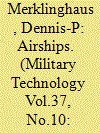

|
|
|
|
|
| Publication |
2013.
|
| Summary/Abstract |
Since the Civil War, when Union Soldiers utilised hot air balloons to serve as a surveillance platform, lighter than air technology has been a part of the military's inventory. As US forces began a troop surge in Afghanistan while maintaining security in Iraq the need to provide soldiers with a persistent view of the battlefield was paramount.
The primary goal of Millennium Airship is to design, engineer, build, market and operate the world's first Heavy-Lift Air Vehicle that is lighter-than-air, all-weather, amphibious semi-rigid, multi-mission, hybrid. The key feature of this aircraft will be in that it is so manoeuvrable that it can operate in and out of virtually anywhere (land or sea) where there is enough space to accommodate its size.
|
|
|
|
|
|
|
|
|
|
|
|
|
|
|
|
| 3 |
ID:
130117
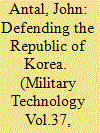

|
|
|
|
|
| Publication |
2013.
|
| Summary/Abstract |
South Korea takes its security issues very seriously. For years the Republic of Korea (ROK) relied on for eign military equipment, primarily from the US, but as the South Korean economy surged, ROK industries became leaders in military technology development and production. One of the areas that the ROK has excelled is in the area of unmanned robotic military systems. This article looks at some of the unmanned systems (UnS) currently developed by the South Korean defence industry.
|
|
|
|
|
|
|
|
|
|
|
|
|
|
|
|
| 4 |
ID:
130667
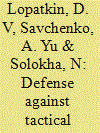

|
|
|
|
|
| Publication |
2014.
|
| Summary/Abstract |
The article focuses on tactical unmanned aerial vehicles (UAVs) and the need to develop an effective defense against drone attacks. Existing weapons and ways to defend against drones are presented. Problems discussed include challenges in detecting and destroying small size UAV's or drones. Options for defending against tactical drones including the use of laser as weapon, powerful electromagnetic impulses that disable drone equipment and drone hunter-killers are also presented.
|
|
|
|
|
|
|
|
|
|
|
|
|
|
|
|
| 5 |
ID:
130342


|
|
|
|
|
| Publication |
2014.
|
| Summary/Abstract |
As the U.S. government winds up an interagency review of rules governing the export of large drones, the conflicting goals of nonproliferation and commerce are creating a new test of the 27-year-old Missile Technology Control Regime (MTCR). Observers do not expect big changes to the MTCR, which seeks to prevent the proliferation of unmanned systems capable of delivering weapons of mass destruction. The MTCR, a voluntary arrangement that now includes 34 countries, originally was intended to curb the spread of ballistic missiles and unmanned vehicles capable of carrying nuclear weapons. In 1993 it was amended to control systems carrying any weapons of mass destruction. It has become Washington's chief tool for controlling the spread of armed drones. "It's quite unlikely that we will see any radical change in the MTCR," Eric McClafferty, an attorney at Kelley Drye and Warren, a law firm in Washington that represents UAV manufacturers, said in a March 19 interview. "That said, there's a lot of pressure on the U.S. government to liberalize controls to make sure the U.S. doesn't get left behind in this market." The conflict has played out in a series of closed-door meetings over the last two months among the State, Defense, and Commerce departments as officials seek to update U.S. policy toward the burgeoning UAV market. Industry representatives have made their views known via technical committees that advise policymakers in these departments. "It's a pretty contentious fight" between the State Department's Bureau of International Security and Nonproliferation and the Pentagon's Defense Technology Security Administration, said Micah Zenko, a fellow at the Council on Foreign Relations, in a March 17 interview. The State Department says that "if you pull at the thread of MTCR, you will weaken the nonproliferation regime as a whole. The other side says the international market is going to supply these UAVs anyway," Zenko said. The heart of the issue is what kind of UAVs U.S. manufacturers can sell overseas. The MTCR imposes a "presumption of denial" for the export of so-called Category 1 UAV's, which are drones that can travel more than 300 kilometers with a payload of more than 500 kilograms. Drones that do not have those capabilities are classified as Category 2 UAVs and are not subject to such restrictive criteria. Two drones currently classified as Category 1-the Reaper, formerly known as the Predator, and the Global Hawk-have played a central role in U.S. aerial attacks on suspected Islamic militants in Pakistan, Somalia, and Yemen. Washington has approved the sale of an armed drone to only one country, the United Kingdom, although unarmed versions of these drones have been sold to Italy and South Korea.
The stakes of the MTCR review process are large politically and economically, observers say.
|
|
|
|
|
|
|
|
|
|
|
|
|
|
|
|
| 6 |
ID:
131319
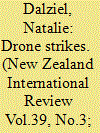

|
|
|
|
|
| Publication |
2014.
|
| Summary/Abstract |
As New Zealand's role in Afghanistan comes to a close, the War on Terror has been relegated to the backseat of the New Zealand public's consciousness, albeit prematurely so. With the first New Zealander killed in a drone strike in Yemen, it is timely that New Zealand reconsider its support for a tactic that opponents argue is itself an act of terrorism. As yet no consensus has been reached as to whether drone strikes constitute a breach of international law. We must, therefore, base our assessment on whether the tactic is ethically and strategically flawed. With every hell-fire missile that Nobel Peace Prize winning Barack Obama rains down on al-Qaeda and any civilians unfortunate enough to be in the way, a New Zealand decision on this question becomes more urgent.
|
|
|
|
|
|
|
|
|
|
|
|
|
|
|
|
| 7 |
ID:
132264
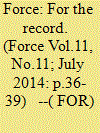

|
|
|
|
|
| Publication |
2014.
|
| Summary/Abstract |
Unlike the four earlier editions of international trade media briefings (TMB) this time around the head of airbus defence and space (military aircraft), Doningo - Urea Raso appeared a bit subdued initially. But it was just play of light in the fading hours of the day at La-Hacienda, a 17th century Andalusian fort of the outskirt of Seville.
|
|
|
|
|
|
|
|
|
|
|
|
|
|
|
|
| 8 |
ID:
130885


|
|
|
|
|
| Publication |
2014.
|
| Summary/Abstract |
Geospatial capabilities offer tremendous potential for driving new cost efficiencies and operational effectiveness for homeland security missions. Geospatial data and technology improve the ability of information technology applications and systems to enhance public security and provide for more effective situational awareness and delivery of a common operating picture. Geospatial information is often the common denominator that links disparate information together to reveal the necessary context and understanding required to connect the dots, and generate actionable information vital for effective decision-making. Location is everything to homeland security. Without geospatial context, we cannot understand where and how events are occurring, nor can we rationalise why they are occurring. The location component is the 'make or break' for nearly all homeland security operations from back office functions such as facilities management, to frontline operations in disaster response, border security, customs enforcement, critical infrastructure and threat reduction.
|
|
|
|
|
|
|
|
|
|
|
|
|
|
|
|
| 9 |
ID:
132251
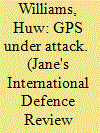

|
|
|
|
|
| Publication |
2014.
|
| Summary/Abstract |
As GPS is central to the performance of many unmanned systems, protecting them from electronic attack, is a growing concern. Huw Williams examines some of the defensive measures and alternative methods of operations
|
|
|
|
|
|
|
|
|
|
|
|
|
|
|
|
| 10 |
ID:
129372
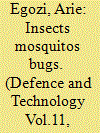

|
|
|
|
|
| Publication |
2012.
|
| Summary/Abstract |
The face of warfare has changed. Kilometers long tank columns and thousands of troops marching forward are scenery from the past. Today's battlefield is an urban terrain swarming with small groups of irregular forces that rapidly switch positions from hindouts to tunnels.
|
|
|
|
|
|
|
|
|
|
|
|
|
|
|
|
| 11 |
ID:
130152
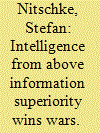

|
|
|
|
|
| Publication |
2013.
|
| Summary/Abstract |
The character of 21st Century warfare is dominated by information warfare and long-range precision
strikes coupled with new forms of C4ISR. This is being achieved by linking intelligence together by a multiplicity of highly advanced sensors carried by high-altitude surveillance platforms, including HALE UAS, purpose-designed AEW&C aircraft, and space-based systems.
|
|
|
|
|
|
|
|
|
|
|
|
|
|
|
|
| 12 |
ID:
129160
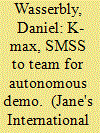

|
|
|
|
|
| Publication |
2014.
|
| Summary/Abstract |
The US army has contracted Lockheed Martin to demonstrate reconnaissance, surveillance, and target acquisition (RSTA) missions with one of tis unmanned ground vehicles (UGVs) and a K-MAX unmanned cargo lifter.
|
|
|
|
|
|
|
|
|
|
|
|
|
|
|
|
| 13 |
ID:
132846
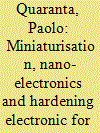

|
|
|
|
|
| Publication |
2014.
|
| Summary/Abstract |
The last decade have been characterized by an ever-increasing importance of electronics in weapons systems, not only from a technological and operational point of view, but also for a high level of costs that currently represent, e.g. in the case of a combat aircraft, 60% of the total cost.
|
|
|
|
|
|
|
|
|
|
|
|
|
|
|
|
| 14 |
ID:
129179


|
|
|
|
|
| Publication |
2014.
|
| Summary/Abstract |
A decade after bringing its widely fielded SMART-S Mk2 3 DE/F band multibeam radar to market, Thales Netherland is preparing to start testing a next generation E/F-band 3D dual axis multibeam radar for which it has equally hopes in the naval marketplace.
|
|
|
|
|
|
|
|
|
|
|
|
|
|
|
|
| 15 |
ID:
131189
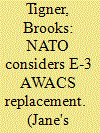

|
|
|
|
|
| Publication |
2014.
|
| Summary/Abstract |
NATO must decide this year on whether and how to replace its against fleet of Boeing E-3 sentry airborne warning and control system (AWACS) aircraft, allied officials have told HIS Jane's.
|
|
|
|
|
|
|
|
|
|
|
|
|
|
|
|
| 16 |
ID:
130886
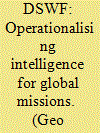

|
|
|
|
|
| Publication |
2014.
|
| Summary/Abstract |
GEOINT 2013* Symposium, organised annually by the United States Geospatial Intelligence Foundation (USGIF), was held at Tampa Convention Centre, Tampa, Florida, from April 14-17, 2014. The symposium, which is renowned for its keynote addresses, educational and training sessions and exhibition, provided an excellent opportunity for networking to the geointelligence community. The conference was originally scheduled to be held in October 2013. However, it had to be postponed due to the unprecedented US federal government shutdown. It was therefore held in April this year, with most of the original agenda intact. The symposium was spread over four days. Day 1, designated as Geoint Foreword, was the symposium's pre-conference session dedicated to innovation, emerging trends and academia. The session was introduced by Dr Darryl Mordock, Vice President Professional Development, USGIF. Dave Snowden, founder and chief scientific officer of the consulting firm Cognitive Edge (not to be confused with Edward Snowden!) delivered the first keynote. He suggested the use of human sensors from ordinary life to create a network. Open source data produced by human geography is valuable, he emphasised. This was followed by selected brief talks, called 'lightening talks', on subjects such as crowd sourced imagery, maritime geoint and race cars. The afternoon was dedicated to talks on subjects such as crowd sourced imagery, interoperability and special ops.
|
|
|
|
|
|
|
|
|
|
|
|
|
|
|
|
| 17 |
ID:
131323


|
|
|
|
|
| Publication |
2014.
|
| Summary/Abstract |
An age-old form of warfare, insurgency is still a problem for many governments today and merits careful study. Regional governments, global coalitions and international security policy-makers--all have an interest in finding the ways and means of countering such challenges. Historical analysis provides a good foundation for understanding the problem and seeking solutions to it. The Rand Corporation has undertaken an extensive and detailed comparative examination of insurgencies begun and completed worldwide since the Second World War, focusing on the 71 most recently resolved conflicts in particular. The findings of this important study provide useful guidelines for implementing an effective counter-insurgency strategy.
|
|
|
|
|
|
|
|
|
|
|
|
|
|
|
|
| 18 |
ID:
128131
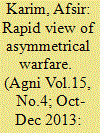

|
|
|
|
|
| Publication |
2013.
|
| Summary/Abstract |
There are a number of theories and definitions of asymmetric warfare but most definitions are inadequate to fully describe the diverse characteristics of asymmetrical warfare, because of diverse forms asymmetric warfare can take it is still obscure. It can hold many surprises and has many unexpected formats and designs. It can hold many surprises fully explored. It is not easy to formulate any standard course of action that can be employed to fight diverse forms of asymmetrical wars. There are clear indications that the current doctrinal concepts of combat have been ineffective in meeting the challenges of asymmetric wars. It is necessary to initiate a comprehensive review of the basic concepts and theories that underpin the doctrines of fighting asymmetrical wars today.
|
|
|
|
|
|
|
|
|
|
|
|
|
|
|
|
| 19 |
ID:
133066
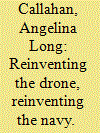

|
|
|
|
|
| Publication |
2014.
|
| Summary/Abstract |
Invention is often perceived as an isolated event, attributable to a momentous "first" or to a single, patent-holding inventor. However, rather than questioning what qualified as the first drone aircraft or to whom the title as its "inventor" belongs, this article maps out the winding uncertainties of technical evolution- exploring how seemingly failed projects laid groundwork for the U.S. Navy's first successful radio-controlled drone aircraft. Situated as they are among a cluster of interwar emerging technologies, drones provide an instructive case study through which to consider how the U.S. Navy's research-and-development (R&D) communities function as a strategic asset. When the availability of one subcomponent can jeopardize an entire research project, such factors as institutional stability, the circulation of ideas, and willingness to reevaluate naval doctrine become critical to national security. So too does the ability of experts to recognize a (perhaps temporary) dead end when they face one. This article will flesh out, for this case, the actors and activities of innovation, emphasizing how the collaborative nature of this work can mitigate the uncertainties
and risks of R&D.
|
|
|
|
|
|
|
|
|
|
|
|
|
|
|
|
| 20 |
ID:
130756
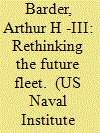

|
|
|
|
|
| Publication |
2014.
|
| Summary/Abstract |
The U.S. Navy has no overall requirements process for designing a Fleet, and it needs one-desperately.
The Navy finds itself caught in the perfect storm between the cost constraints of the national budget environment and the capability demands of globally proliferating counter-naval technologies. At present projected budget levels, if we continue our current processes for setting the design requirements of future ships and aircraft, the service's size will shrink over the next two decades to about two-thirds of today's force-structure goals of 306 ships and 3,000 aircraft. Unless we find more efficient ways to generate forward deployments out of this fleet, the Navy's forward posture-its key contribution to national strategy and joint U.S. military capability-will shrink to far less than the 100 deployed ships typically used to deliver global capability. This is not the right path.
It is time to rethink how we will design the future Fleet in a way that rebalances affordability, platform capability, and deployment processes. We must build it as a whole instead of continuing to "let it happen" one platform requirements decision at a time.
|
|
|
|
|
|
|
|
|
|
|
|
|
|
|
|
|
|
|
|
|